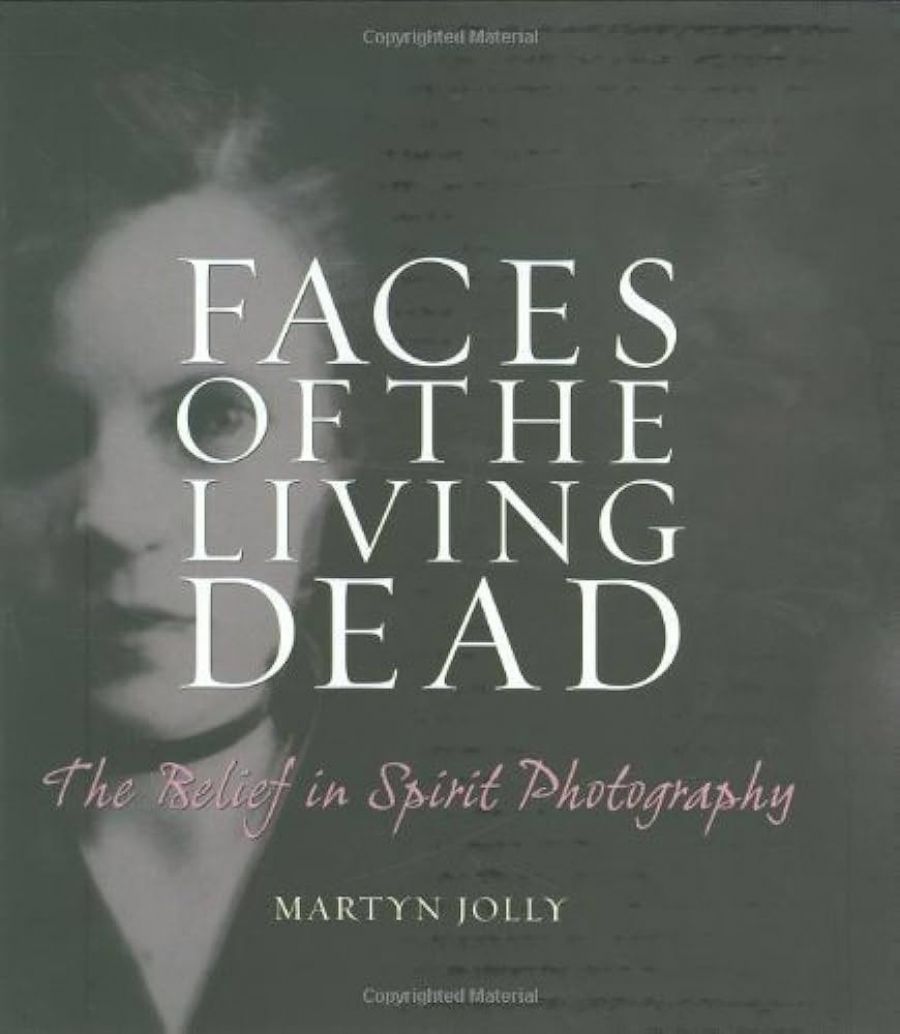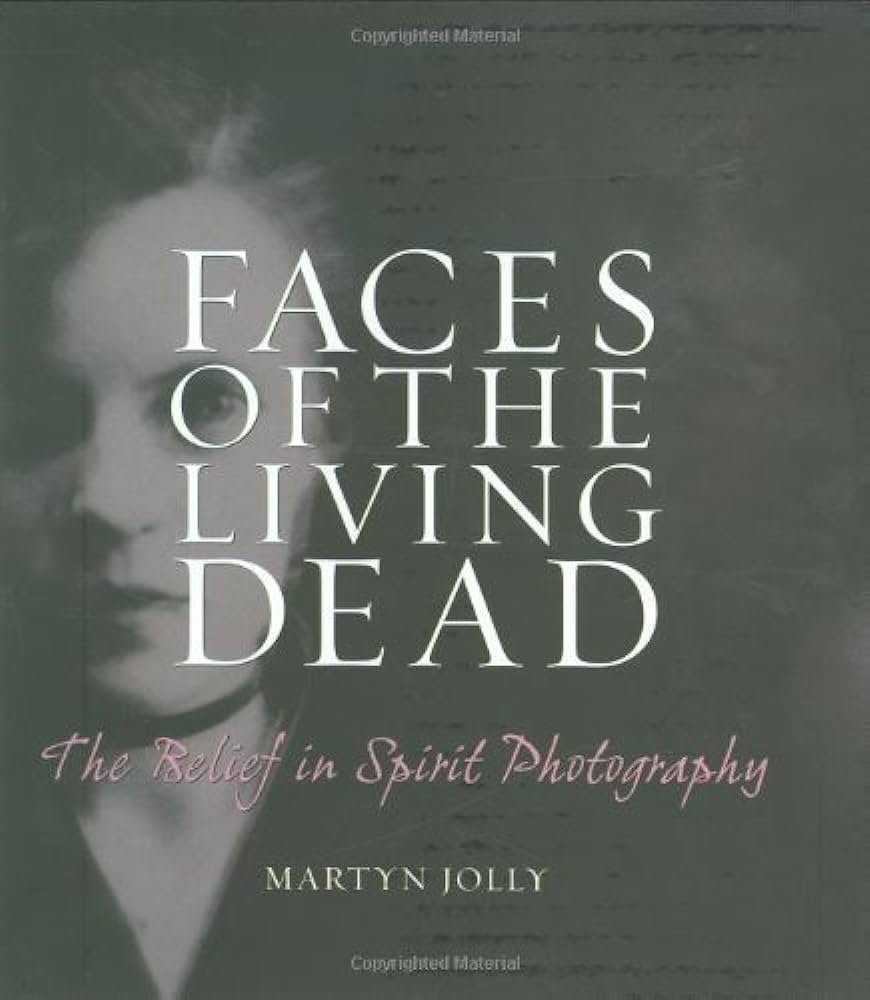
- Free Article: No
- Contents Category: Photography
- Review Article: Yes
- Article Title: Auras of the dearly departed
- Online Only: No
- Custom Highlight Text:
Photography has always had a close relationship with death, indeed one of the more poignant catch cries of early portrait photography exhorted clients to ‘secure the shadow, before the substance fade’. An intriguing part of this emotionally charged territory is spirit photography – a sub-culture of photographs from the mid-nineteenth to early twentieth centuries that purport to show ectoplasms, ghosts and auras of the dearly departed.
- Book 1 Title: Faces of the Living Dead
- Book 1 Subtitle: The belief in spirit photography
- Book 1 Biblio: Miegunyah Press, $49.95 hb, 153 pp
- Book 1 Cover Small (400 x 600):

- Book 1 Cover (800 x 1200):

In 1960 Eric Dingwall dismissed one large collection of spirit photography held in the British Library as evidence of ‘human stupidity, credulity and superstition’. Certainly, viewing many of the photographs from this collection in Martyn Jolly’s beautifully produced book, the frauds and deceptions that photographers played with the material world (and their vulnerable clients) can seem crude and exploitative. But to dismiss these photographs as simple trickery is to miss the point. As Jolly perceptively writes, spirit photography reveals as much about love, desire and faith as it does about human gullibility. The need to believe is deeply inherent in most of us, and even entrenched cynics may find their views on an afterlife tested when someone they love dies. There is no doubt that such a hope impelled those who viewed these photographs to see them as incontrovertible evidence of a spirit world.
Spirit photographers were invariably connected with psychic research and spiritualism – a fascinating field that conjures shadowy Victorian parlours with séances, mediums and wispy apparitions. Jolly introduces us to some of the main characters in this controversial area through their inevitable public trials, causes célèbres and embarrassing exposures. Colourful individuals include the spiritual evangelist Sir Arthur Conan Doyle and the sweet-looking elderly British psychic, photographer and fraudster, Ada Deane. Another notable American photographer was William Mumler, who narrowly escaped prosecution for forgery in his trial in 1869. Mumler’s trial was as notable for his supporters – described by the newspapers as a ‘motley array of believers with sickly sentimental eyes and cadaverous lantern-jawed physiognomies’ – as for the descriptions of how he added spirits to his photographs by pre-exposing a spectral figure onto the glass plate that contained his client’s portrait.
As Jolly observes, the advent of spirit photography coincided with a time of great human losses. Mumler began his trade in images of the deceased after the outbreak of the American Civil War, and spiritualism surged in popularity following World War I and the influenza epidemic of 1918–19. Spirit photography was also significantly aided and abetted by contemporary scientific innovations, most notably advances in electricity and telegraphy, which extended the limits of human perception concerning energy. It was a relatively easy matter for spiritualists to draw on nebulous scientific language when introducing concepts of ‘psychic residues’, often combining plausible sounding concepts with a sleight of hand more common to a magic performer.
One of the most famous ‘psychic scientists’ was Sir William Crookes (an inventor and Fellow of the Royal Society), who found himself drawn into the world of spiritualism and séances following the loss of his young brother in 1867. Personal factors may have sparked Crookes’s interest, but his scientific nature prompted him to him use experimental techniques in his psychic investigations. Rigging elaborate photographic devices to capture the spirit world, Crookes’s professional detachment seems to have gradually waned as the spell of the otherworldly seduced him. As Jolly evocatively writes, ‘Crookes had begun the test séances with a professed commitment to the objective scientific recording of observable phenomena. But within the crepuscular hush of the séance he was as beguiled by the spirit’s ethereal, yet palpable, beauty as everyone else.’
So what to make of the resulting photographs? The book designers have often enlarged details from a diverse range of spirit photographs to make the most of the spectral material at their disposal. Some of the photographs are relatively innocuous and charming, with pale, ethereal figures hovering around the corporeal form of an earthbound wife or sibling. However, some are downright strange and disturbing. Chief amongst these are the ‘ectoplasm portraits’, which show a kind of messy, wet organic matter that was claimed as an extension of spirit materialisations. The photographs of this ‘life force’ extruding from the noses, mouths and even vaginas of subjects, sometimes in the shape of human portraits, are truly odd – but mesmerising.
At first glance, spirit photography may seem like a naïve longing for proof of an afterlife, but before we feel too superior, it is perhaps interesting to think about our modern sensibilities. If television and movies are a guide to contemporary interests, then popular culture is still rife with a fascination with the supernatural. Few people may now believe that the camera can really record the paranormal, and contacting the ‘other side’ seems to be largely the province of telephone clairvoyants, but the interests are essentially the same. Jolly’s meticulously researched and engagingly written book has a timeliness that transcends the distinct historical moment that he so ably documents. While some of his material intersects with another recent book on the subject (The Perfect Medium: Photography and the Occult, by Clement Cheroux et al.), Jolly has an intelligent approach to his subject that makes this publication a distinct contribution to the field.
Faces of the Living Dead may speak to photography’s relationship with the material and non-material world, but more than anything Jolly engages with the overpowering human need for those we love never to leave us. As he writes: ‘Although the product of extreme credulity, spirit photography was nonetheless a collective act of imagination … In many ways, spirit photographs served the same function as precious family photographs … they didn’t find their truth in the documentation of a prior reality, they created their truth within the wounded psychology of their audience.’


Comments powered by CComment